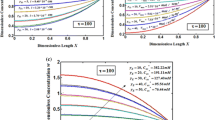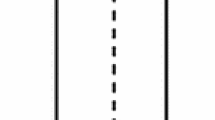Abstract
The theory of glucose-responsive composite membranes for the planar diffusion and reaction process is extended to a microsphere membrane. The theoretical model of glucose oxidation and hydrogen peroxide production in the chitosan-aliginate microsphere has been discussed in this manuscript for the first time. We have successfully reported an analytical derived methodology utilizing homotopy perturbation to perform the numerical simulation. The influence and sensitive analysis of various parameters on the concentrations of gluconic acid and hydrogen peroxide are also discussed. The theoretical results enable to predict and optimize the performance of enzyme kinetics.










Similar content being viewed by others
Abbreviations
- \(C{}_{g}\) :
-
Concentration of glucose (mol/cm3)
- \({C_{{\text{OX}}}}\) :
-
Concentration of oxygen (mol/cm3)
- \({C_a}\) :
-
Concentration of gluconic acid:mol/cm3
- \({C_h}\) :
-
Concentration of hydrogen peroxide (mol/cm3)
- \({D_g}\) :
-
Diffusion coefficient of glucose (cm2/s)
- \({D_{{\text{OX}}}}\) :
-
Diffusion coefficient of oxygen (cm2/s)
- \({D_a}\) :
-
Diffusion coefficient of gluconic acid (cm2/s)
- \({D_h}\) :
-
Diffusion coefficient of hydrogen peroxide (cm2/s)
- \({K_g}\) :
-
Michaelis–Menten constant for glucose:mol/cm3
- \({K_{{\text{OX}}}}\) :
-
Michaelis–Menten constant for oxygen (mol/cm3)
- \({V_{\hbox{max} }}\) :
-
Maximal reaction velocity (cm/s)
- \(\begin{gathered} {v_g},{v_{OX}}, \hfill \\ {v_a}\,{\text{and}}\,{v_h} \hfill \\ \end{gathered} \) :
-
Stoichiometric coefficients (None)
- \(t\) :
-
Time (S)
- \(C_{g}^{*}\) :
-
Concentration of glucose in the external solution (mol/cm3)
- \(C_{{{\text{OX}}}}^{*}\) :
-
Concentration of glucose in the oxygen solution (mol/cm3)
- S:
-
Radius of the microsphere (\(\mu {\text{m}}\) )
- u:
-
Dimensionless concentration of glucose (None)
- v:
-
Dimensionless concentration of oxygen (None)
- w:
-
Dimensionless concentration of gluconic acid (None)
- H:
-
Dimensionless concentration of hydrogen peroxide (None)
- \(\Re \) :
-
Overall reaction rate (None)
- T:
-
Dimensionless time (None)
- \(\begin{gathered} {\gamma _g},\,{\gamma _{{\text{OX}}}}, \hfill \\ {\gamma _a},{\gamma _h},\alpha \hfill \\ \beta \,\& \,k \hfill \\ \end{gathered} \) :
-
Dimensionless reaction diffusion parameters (None)
- R:
-
Dimensionless radius (None)
References
Szatrowski TP, Nathan CF (1991) Production of large amounts of hydrogen peroxide by human tumor cells. Cancer Res 51:794–798
Abdekhodaie MJ, Wu XY (2009) Modeling of a glucose sensitive composite membrane for closed loop insulin delivery. J Membr Sci 335:21–31
Albin G, Horbett TA, Ratner BD (1990) Glucose sensitive membranes for controlled deliver of insulin. In: Kost J (ed) pulsed and self-regulated drug delivery. CRC Press, Boca Raton. F, pp 159–185
Rajendran L, Bieniasz LK (2012) Analytical expressions for the steady-state concentrations of glucose, oxygen and gluconic acid in a composite membrane for closed-loop insulin delivery. J Membrane Biol 246:121–129
Abdekhodaie MJ, Cheng JI, Wu XY (2015) Effect of formulation factors on the bioactivity of glucose oxidase encapsulated chitosan-alginate microspheres: In vitro investigation and mathematical model prediction. Chem Eng Sci 125:4–12
Abdekhodaie MJ, Wu XY (2005) Modeling of a cationic glucose sensitive membrane with consideration of oxygen limitation. J Membr Sci 245:119–127
Gough DA, Lusisano JY, Tse PHS (1985) Two-dimensional enzyme electrode sensor for glucose. Anal Chem 57:2351–2357
Klumb LA, Horbett TA (1992) Design of insulin delivery devices based on glucose sensitive membranes. J Control Release 18:59–80
Trachootham D, Alexandre J, Huang P (2009) Targeting cancer cells by ROS-mediated mechanisms: a radical therapeutic approach? Nat RevDrug Discov 8:579–891
He JH (2006) Homotopy perturbation method for solving boundary value problems. Phy Lett A 350:87–88
He JH (2004) Comparison of homotopy perturbation method and homotopy analysis method. Appl Math Comput 156:527–539
He JH Hong Wu Xu (2006) Construction of solitary solution and compact on-like solution by variational iteration method. Chaos Solitons Fractols 29:108–113
He JH,Wu XH (2007) Variational iteration method: new development and applications. Comput Math Appl 54:881–894
Adomian G, Witten M (1994) Computation of solutions to the generalized Michaelis–Menton equation. Appl Math Lett 7:45–48
Adomian G (1995) Solving the mathematical models of neurosciences and medicine. Math Comput Simul 40:107–114
Wazwaz AM, Gorguis A (2004) An analytic study of Fishers equation by using Adomian decomposition method. Appl Math Comput 154:609–620
Loghambal S, Rajendran L (2013) Analytical expressions for steady-state concentrations of substrate and oxidized and reduced mediator in an amperometric biosensor., Int J Electrochem. doi: https://doi.org/10.1155/2013/812856
He JH (2006) Exp-function method for nonlinear wave equations. Chaos Solitons Fractals 30:700–708
Rajendran L, Anitha S (2013) Reply to “Comments on analytical solution of amperometric enzymatic reactions based on homotopy perturbation method,” by Ji-Huan He, Lu-Feng Mo [Electrochim.Acta (2013)]., Electrochim Acta 102:474–476
Liu Z-J, Adamu MY Enoch S ,J-H He (2017) Hybridization of homotopy perturbation method and Laplace transformation for the partial differential equations. Thermal Sci 21(4):1843–1846
Adamu MY, Ogenyi P (2017) Parameterized homotopy perturbation method. Nonlinear Sci Lett A 8(2):240–243
He JH (1999) Homotopy perturbation technique. Comput Methods Appl Mech Eng 178:257–262
Ganesan S, Anitha A, L Rajendran (2013) Mathematical modeling of a carrier-Mediated transport process in a liquid membrane. J of Membrane Biol 246:435–442
Rasi M, Rajendran L, Sangaranarayanan MV (2015) Enzyme catalyzed oxygen reduction reaction in biofuel cells: Analytical expressions for chrono amperometric current densities. J Electrochem Soc 162(9):H671-H680
Author information
Authors and Affiliations
Corresponding author
Ethics declarations
Conflict of interest
There are no conflicts of interests.
Electronic supplementary material
Below is the link to the electronic supplementary material.
Rights and permissions
About this article
Cite this article
Saranya, K., Mohan, V., Kizek, R. et al. Unprecedented homotopy perturbation method for solving nonlinear equations in the enzymatic reaction of glucose in a spherical matrix. Bioprocess Biosyst Eng 41, 281–294 (2018). https://doi.org/10.1007/s00449-017-1865-0
Received:
Accepted:
Published:
Issue Date:
DOI: https://doi.org/10.1007/s00449-017-1865-0




